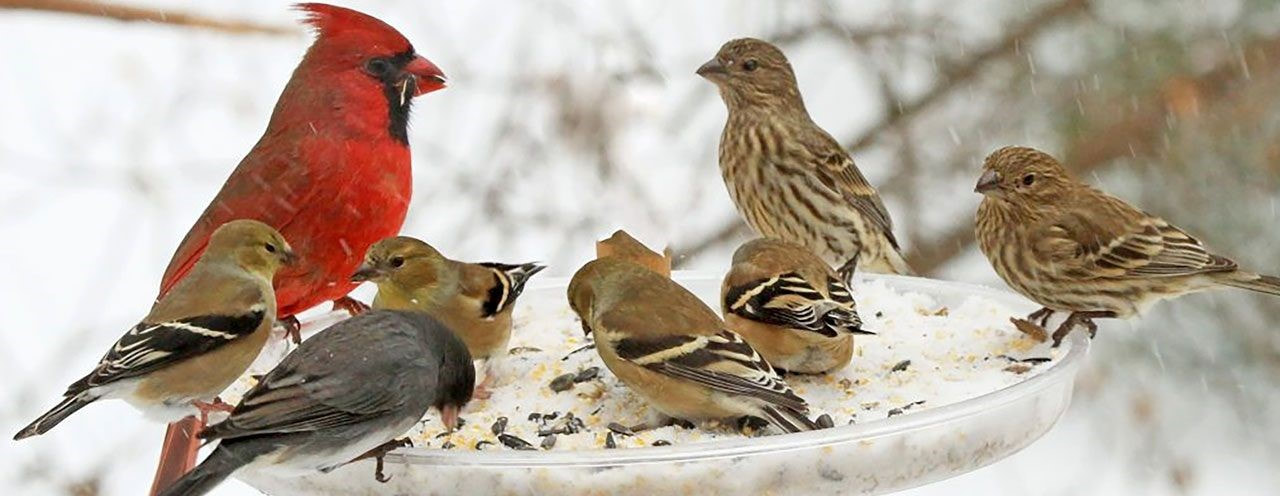CONSERVATION CORNER
A weekly blog for all things conservation
 Excerpt taken from Northcentral Pennsylvania Conservancy (NPC) newsletter. To learn more about NPC or to sign up for their newsletter, visit https://npcweb.org/ As the days get colder and natural food sources dwindle, many people provide supplemental food to help our native songbirds survive through the winter. This is also a great opportunity to recognize, enjoy, and learn about the bird species in your area. Whether you already have feeders set-up or you’d like to start, this article may provide some tips for success What a Bird Eats
Different bird species eat different things. While a Mourning dove likes cracked corn, a Red-bellied woodpecker prefers suet. What you put out in your feeder will be a large factor in determining who you end up seeing at your feeder. Penn State University’s Dr. Margaret C. Brittingham, Professor of Wildlife Resources, recommends small black-oil sunflower seed as the best all-round bird seed. In a publication she wrote for Penn State Extension she noted, it “is preferred by many smaller species, including chickadees, nuthatches, and titmice. It has a high oil content that is nutritionally important for birds, and a thin seed coat that is easy for them to crack open.” Dr. Brittingham also suggests providing a variety of foods to help increase the variety of birds you see. Your feeder will need to be one designed to dispense the seed. For instance, striped sunflower seeds are larger than the black-oil sunflower seed. A feeder that easily lets the black-oil sunflower seed out might jam up because striped sunflower seeds are too big to exit the holes in the feeder. She recommends using a seed mix if you’re interested in a variety of birds, but don’t have the desire to maintain a variety of feeders, or space for a variety of feeders. She does caution, that some mixes contain items that birds in our region don’t eat, so you want to be sure to read the label and pick a seed mix that “fits” what birds in your area eat. Dr. Brittingham shares the recipes for “Marvel Meal,” a favorite for chickadees, titmice, wrens, and bluebirds. The mixture can be smeared on the trunk of a tree, or a tree stump. You can also freeze the mixture into blocks, slice it and put it in a suet feeder or put it on a feeder tray. 1 cup peanut butter 1 cup vegetable shortening 4 cups cornmeal 1 cup flour 1 handful of sunflower seeds (optional) Where's Your Bird Feeder Located? Where you place your bird feeder will impact who visits your bird feeder. Birds like cover. You’ll want the feeder to be within 10 feet of some trees or shrubs. This will allow the birds to check things out before venturing to the feeder. You should also think about a water source for the birds visiting your bird feeder. In the winter, water can be especially hard to find. A birdbath, or other shallow container can work well for birds needing a drink or a bath. Something to keep in mind with both your bird feeder and birdbath is while you want some shrubs nearby, if there’s too much cover, your cat (or your neighbor’s) will find the shrubbery a great place to hide and wait for birds. The U.S. Fish and Wildlife Service estimates that between 1,400,000 and 3,700,000,000 birds are killed annually by cats. That’s a really big number. So, keep cats in mind when placing your feeders. A Chart to Help You Decide What to Fill Your Feeder With Penn State Extension provides the following to help you understand, who eats what, and what kind of feeder you need for that food source: Species - Food Preference - Feeder Preference
The Bradford County Conservation District is committed to helping people manage resources wisely. You can visit the Bradford County Conservation District at 200 Lake Rd in Wysox across from the Wysox Fire Hall. Contact us at (570) 485-3144 or visit our web page at www.bccdpa.com
1 Comment
2/27/2020 10:26:40 am
It makes sense that you should place your bird feeder close to a nearby tree so that birds have a chance to observe the feeder before using it. My wife would like to start photographing wildlife for a school project and needs to find a way to attract some birds to our backyard this summer. Maybe we should get a feeder to help bring more animals to our property.
Reply
Leave a Reply. |
AuthorsVarious staff at the Bradford County Conservation District Archives
April 2024
Categories
All
|
